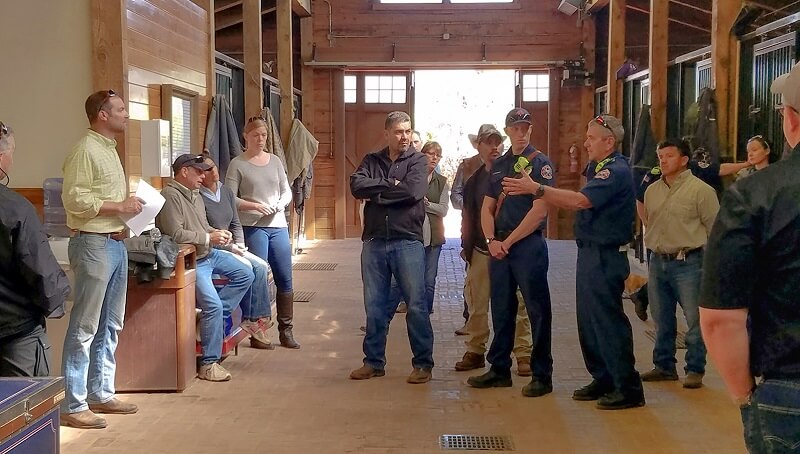Your local fire department is a great resource.
This year alone, 77 horses have already died in the U.S due to barn fire—already in June, surpassing the annual average for the last three years. One of my responsibilities, as an architect, is to design buildings that safeguard the health and welfare of their occupants, and as an architect who designs equestrian projects, whether it’s a renovation or the design of a completely new facility, this includes the people and the animals. In my daily job, I use the applicable building and fire codes to ensure that the projects I design meet or exceed the minimum standards. Occasionally, I’m contacted by potential clients who simply want to reduce the risk of fires and improve the safety in and around their equestrian property.
While I’m more than happy to come to their property for a consultation, I usually tell them to do the same thing I do—reach out to their local fire department. When I research regulations of a certain code or have a question about how a particular standard might be applicable to one of my projects, I call the local fire department where the property is located. It’s one of the best resources you have available when thinking about barn safety and fire protection. I first started designing and working on equestrian projects in 2008, and I was often surprised how hesitant some people were to have their local fire department come out and do an assessment of their property, perhaps thinking they’d get in trouble if there were hazards the fire department could point out. In my experience, this couldn’t be further from the truth. Every department I’ve worked with has been more than accommodating. The safer they can help you make your property, the safer it keeps them if there ever is an emergency. To this end, here are three key elements where I think local fire departments can be invaluable.
Element 1: Property Assessment
The first is in helping you assess your property and identifying areas where improvements can be made to reduce the risk of a fire. Barn safety checklists are a good start, and there are many available online. The National Fire Prevention Association has a very good list located here: https://www.nfpa.org/-/media/Files/Public-Education/Resources/Safety-tip-sheets/BarnSafetyChecklist.ashx.
But every equestrian property is different, and lists may not capture hazards for all facilities. Scheduling a walkthrough with your local fire officials can help you identify those hazards that may be unique to your property.
Element 2: Gain Familiarity With Your Property
A property walkthrough and analysis can help your community first responders get a better understanding of the layout of your property and structures, which can save them valuable time if there ever were an emergency. Having a better understanding of your facility layout, access points, and where hazards are located will help them more quickly assess the situation and enact a plan to address the emergency.
Element 3: Free Advice
Most local fire districts have educational tools that you can access for little or no cost. For example, let’s say you’ve decided to reduce the risk of fire in your barn and put together a life safety plan for your property or facility. You’ve downloaded the checklists and addressed the issues you found, including updating the fire extinguishers and placing them in the proper locations around your barn. But have you ever used a fire extinguisher?
A fire chief once told me that barn fires usually become “fully involved” within 5 to 7 minutes after the initial ignition. “This means you only have about 3 or 4 minutes to do what you’re going to do” he said. “And after that, the fire is going to do what it’s going to do, until we arrive.”
What are you going to do with those 3 to 4 minutes?
In an emergency, after you’ve assessed the situation, called 911, made sure that everyone is safe, and evacuated the animals to a safe location out of harm’s way, you conclude that controlling the fire with a fire extinguisher is a safe next course of action. Do you and everyone else who works on and uses your facility know how to use one? Have you ever practiced with one before? Remember, you only have 3 or 4 minutes. Fumbling around and reading instructions wastes valuable time in an emergency, and knowing the best way to approach and attack a fire with an extinguisher is key. Every second counts. Knowledge about how to safely use a fire extinguisher and understanding their capabilities can have a tremendous impact on the outcome of the situation.

Most fire departments offer courses where you can learn about and sometimes practice with a fire extinguisher. If you have a large enough group, they might even come to your facility to do the training. On one of my projects, we hosted a barn safety and fire prevention workshop that included facility staff and the local fire department. During the workshop, we reviewed the barn safety checklist for the facility, gave a tour of the facility to the local firefighters, and had them conduct a fire-extinguisher training courses—complete with mock stall fires in a controlled environment. By the end of the workshop, the firefighters had a better understanding of the facility and were much more comfortable around horses, the staff was much more confident they had the knowledge and skills to handle an emergency in the event of a fire, and they had a much better understanding of the capabilities of fire extinguishers and how to use them quickly and safely.
If you’re looking to improve safety and reduce the risk of fire on your equestrian property, one of the best resources you have available is located right in your own community: your local fire department or district.
2022 Barn Fire Statistics By State. (n.d.). Retrieved from Animal Welfare Institute: https://awionline.org/content/2022-barn-fire-statistics-state
See this article in the September/October 2022 online edition:
September/October 2022

Rodney Kazenske is a licensed architect with over 35 years of experience in architectural design and construction. His firm, Yardstick Studio LLC, specializes in custom residential and equestrian architectural design and planning. Incorporating the principles and elements of beauty, functionality, health, safety, and welfare into his designs, he provides inspired and innovative living solutions for his clients and their horses.

